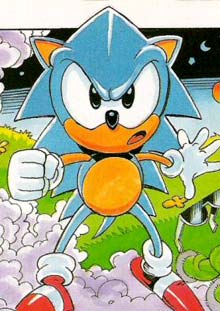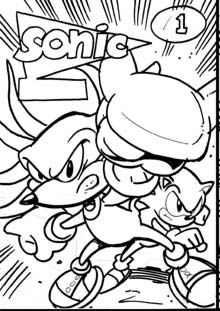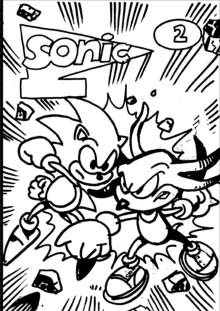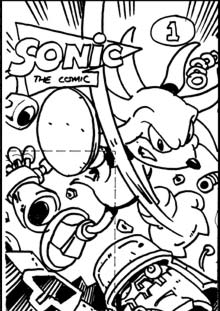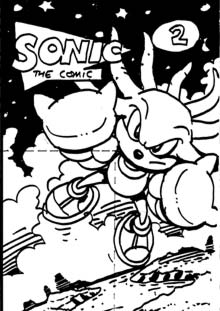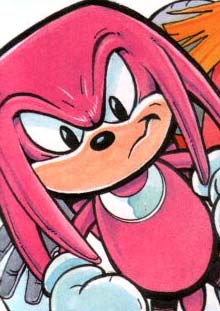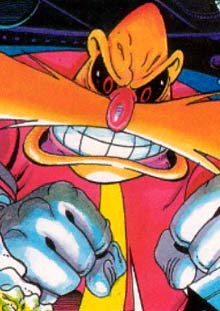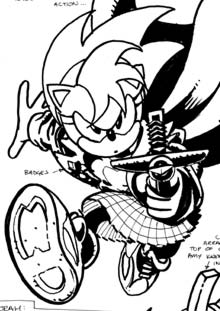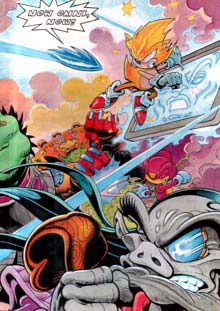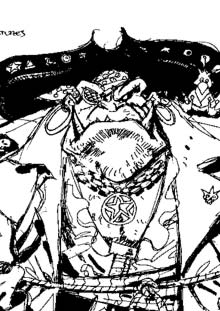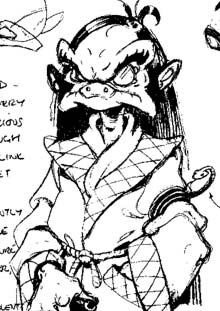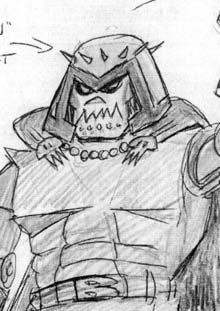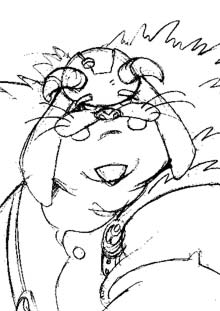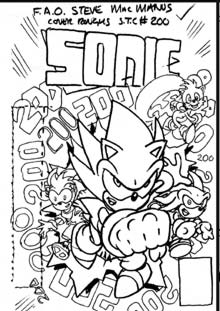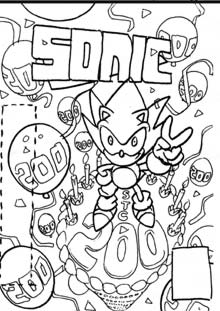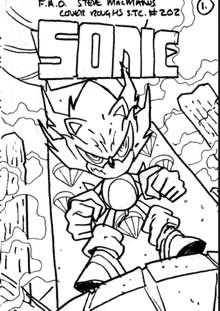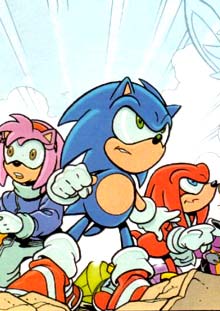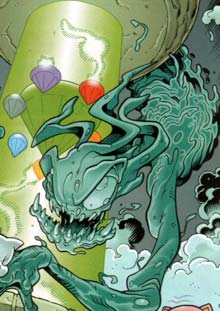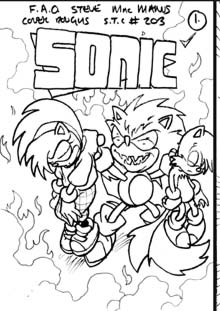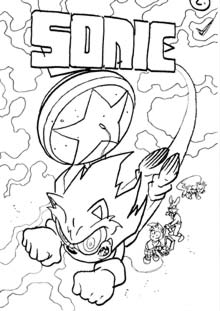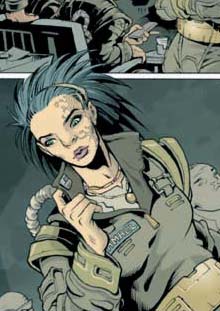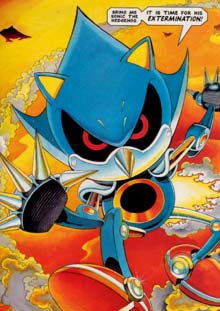

Richard Elson Interview, by Adamis
- How did you come to comics? Was it a child dream to be a comic artist?
I read and loved comics as a child. When I was young, I used to sell Hulk drawings at school and use the money to buy my own comics. I pretty much stopped reading them at eleven but, to fill time during the day in a boring job I was doing at the time, I started reading Heavy Metal when I was in my late teens. This re-ignited my interest briefly and I drew a comic strip that I sent off to a few publishes. This lead to my first professional commission, when I was seventeen, for a British music paper called Sounds. I sort of lost interest again and went back to college to do a degree in Fine Art (as I was unemployed at the time). After finishing my degree I realised I needed to make some money and didn't know how to do anything other than draw so remembering that I'd previously made money selling a comic strip, I decided to try it again. It took about two years of effort before I got regular work, but since 1990 I've hardly had a day when I haven't been busy.
My whole aim as a comic creator is to recapture the magic that I felt when I read comics as a small boy. I still believe that my best work is ahead of me and I am convinced that I will one day do a comic that I am even more proud of than I am of my work on STC. It's just a matter of getting it out of my head and on to the paper.
- How did you get hired on Sonic the Comic? Did you apply for the job or did someone talked to the staff about you?
In the early nineties I spent a bit of time working on the British Teenage Mutant Hero Turtles comic. Barrie Tomlinson, the editor of TMHT, was asked to put together the first Sonic the Hedgehog Yearbook for British release; this was the year before STC was launched. Barry asked me to draw the cover, an eight page comic strip (written by Alan McKenzie) and an illustration to compliment a text piece in the Yearbook. A short time later, my family and I moved house so I got in contact with everybody I knew to let them know our new address. Richard Burton, who had been the editor on a strip I'd drawn for 2000AD in 1990, was one of the people that I contacted and he had just been moved from 2000AD to set up and oversee the new Sonic comic. When he told me about this I mentioned to Richard that I had recently drawn a few Sonic pages for the Yearbook and he invited me to try my hand at one of Nigel Kitching's scripts for STC as they were looking for a regular artist. I am, to this day, very grateful to Richard for this opportunity.
- What was your feeling working for a kid’s comic, with those cute animal characters?
Even though I had worked for 2000AD, Marvel and the Eagle on adventure strips, I'd also drawn The Turtles and the Toxic Crusaders in a cartoony style. I was, and am, very happy doing both. I like to think that I'm a pretty versatile cartoonist. The thing that really interests me about this job is the drawing. I love drawing and I get as much enjoyment and satisfaction from drawing a funny animal as I do a 'serious' illustration. I also believe that both methods of drawing are equally effective at conveying a story, and being able to relate to abstracted, or simplified, characters can, in my opinion, be an indication of intellectual maturity. Only relating to very realistic drawing styles seems to indicate a rather adolescent mind-set, to me.
- Did you think Sonic the Comic would last all that time?
When these things start nobody really has a clue as to how long they will last. We had luck on our side with STC. Sonic is one of those characters that has an instant mass appeal and he brought a large audience of fans from the games who were eager to read further adventures. We were also blessed in that Richard Burton assembled a core creative team that really enjoyed what they were doing and had genuine respect and admiration for each other's work. It did have a real family atmosphere working on STC and after a couple of years on the title it felt like it might run for a very long time because the quality of the work and the loyalty of the audience made for a magic combination that is very rare in comics (or anywhere else for that matter). I think that as soon as the readers began to feel betrayed, by the introduction of reprints, then the demise of the comic was inevitable. Fleetway didn't realise that our audience had grown up with us and stayed loyal. They thought that the original readers would have moved on after five years and that the new audience would accept the reprints as new material. That was the principle reason for the eventual demise of the comic in my estimation.
- What were your colouring techniques in your strips? Some pages looks painted. Did you use watercolours or something like this?
On the early strips I used liquid acrylics then switched to bottled watercolour inks to colour the strips. The watercolours that I used were Dr. Ph. Martin's Radiant Concentrated Water Color (they're American, as you can probably tell by the spelling). I began using Photoshop as soon as I got a scanner for my first computer. I think the cover to issue 125 was the first computer coloured work that I had printed, but that was coloured after the haunted house story [in #126] which was my first interior computer coloured work.
- How much time do you spend per page? Do you sketch a lot before inking?
I do preliminary sketches now, but in the days of STC I mostly drew straight onto the page. The amount of time I take depends on the complexity of the job. Some scripts require a lot of research and detail; others are simple and easy to draw. When I was working on STC I used to plan to do four colour pages per week. Some weeks I did three; I do have a tendency to be a bit lazy and am easily distracted.
- What are your favourite stories from STC? Are there particular reasons for it?
I really enjoyed Decap Attack. That was probably the most enjoyable read, for me. It would have been great to draw one. Although it's not very popular with anybody that I've ever spoken to, the Captain Plunder strip, Shanghaied, that I mostly wrote (though never got a credit on) is a favourite of mine, just because it's the only thing in print that I've written that doesn't totally suck! Of course it helped that Nigel was overseeing it, tidying it up and making the jokes funnier. The final Chaos storyline and the Drakon Empire stuff were the highlights of the Sonic stuff I worked on.
- I noticed Knuckles the Echidna wears some kind of collar instead of having a white moon crescent "painted" on his torso. Did you come with this idea?
I drew Knuckles with a collar because that's what I thought it was. The first game screen shots and character references that Sega/Fleetway sent over to me didn't make it clear what the thing around Knuckle's neck was, so I just assumed that it was a collar.
- Were you and Nigel Kitching planning to use the characters from the "Sonic the Hedgehog" cartoon? I heard that, at one point, Mr Kitching wanted to use Snively.
I rang Nigel to ask him about this. It turns out that when he was sent information about the animated series he assumed that he was to use all of those characters for the comic, so wrote a script with Snively in it. Richard Burton informed him that Sega didn't own the rights to the character as he was a creation of the animation company, so Nigel created Grimer to replace the Snively character in the plot that he had written.
- Before the Sonic CD adaptation, the design of Dr Robotnik was changed to look like the one from "Adventures of Sonic the Hedgehog". Whose decisions was it?
The only times I remember costumes being changed without Sega's direction were at Nigel's request. He wanted to change Amy out of the little girl clothes that she wore in the early game designs and originally suggested a Scully (from X-Files) type Trench coat. Richard Burton didn't agree with that idea but was quite happy to get her out of her 'girly' attire. It was also at Nigel's suggestion that we introduced the Sgt. Pepper-type jacket design for Robotnik, for the Chaos storyline. I think Nigel thought that the redesigned jacket from the game [Sonic Adventure] made Robotnik look less of a comedy figure.
- I must say the idea of Super Sonic being an evil demon (and later be a separate character) is one of the best concept STC had! How did you come up with that idea? Usually people use Super Sonic as "just" a super-powered Sonic who is still a nice hero.
Nigel's real strength as a writer lies in his ability to give characters the type of personalities that generate a lot of story potential. He thinks very deeply and with great clarity about these things. He's not comfortable writing bland characters and always tries to give each personality an edge that will lead them into situations of conflict, danger, humour etc. You'd need to ask Nigel to find out his exact reasoning on the specifics of Super Sonic's problems.
The idea to split Super Sonic was one of mine. We wanted to do something unusual with the character. Nigel and I used to talk on the phone for about an hour a day when we were working on Sonic together. A lot of this time was spent throwing around ideas for the characters and plots. I remember we were at a bit of a sticking point with Super Sonic and had spent a few days discussing how to end the story we were working on. Like many of our best ideas the idea of the split character came from a chance remark during one of these phone calls.
- Have you participated in the writing of some stories? Were you able to exchange your ideas with Mr. Kitching? Do you remember some of them?
As I mentioned above, Nigel and I talked together every day on the phone. A lot of the story ideas came out of these conversations and Nigel would go away and take the bits that worked and throw out the bits that didn't and assemble the whole into a workable story. I would throw in as many ideas as I could and Nigel would reject a lot and use a few. The idea of the Drakons turning out to be fish in mechanical bodies was one of my ideas. Occasionally I would have a larger input into a story and very occasionally I would do the majority of the work. As I mentioned above the Captain Plunder story Shanghaied was one that I wrote and drew. The finished art and dialogue were sent to Nigel who then tidied up my dialogue and added a few funny lines. Unfortunately, due to some sort of mix-up, I didn't get a credit for writing the strip. I'm still a bit sore about this because it's a job that I was very proud of, at the time, and it would have been nice to get a credit for my writing work.
- Have you created characters for STC? I've heard you created Dr Zachary but I never saw him drawn in your style, except for a little picture of him in issue 100. Did you create the characters based on the scripts?
I came up with the entire plot for the first Zachary story, with the robot, the crushing of the emerald and the departed Echidna race, and I also did a design for Zachary. Due to the amount of work I was doing elsewhere, Nigel asked if he could do the story with Nigel Dobbyn. I said that was fine. I didn't show my design to Nigel Dobbyn, who came up with his own interpretation of the character. I do remember saying that Zachary should be white as he was, in my original plot, a very old Echidna. He was a lot older in my design; he looked a lot more wrinkled and evil.
Often I would design characters to go with Nigel's stories after he had written them. Occasionally I would come up with a character idea, fax it to Nigel (these were the days before email) and he would come up with a story to suit the character that I had designed. Arnhem Abacus, Lord Sidewinder, Mr. Fry, Bio-Hazard, Lightmare and Hobson and Choy were created in this way. I also designed a couple of characters called (if I remember correctly) Dr Quark and Miss Mass that I was always pestering Nigel to use, but he always resisted those, for some reason.
- Ah, Hobson and Choy. Were they based on Asterix & Obelix?
Actually, no. I know that they are very much like Asterix & Obelix (and they were originally French, believe it or not). At the time, I was re-reading Jack Kirby's Tales from Asgard stories in the back of his Thor comics, for Marvel. Kirby introduced a group of characters that were very much like the three Musketeers (Fandral, Hogun and Volstagg). I enjoyed the comedy relief and slapstick that these characters introduced to the adventure stories in Tales of Asgard, so set about creating a similar group as villains for STC. I decided on two characters, because I originally wanted to name them Hobson and Choisir (which I think is French for “to choose”). Have you heard the saying Hobson's Choice? It means that you have two choices, but both of them will probably lead to a bad outcome. This was how I thought of these two characters. They both make any situation into a disaster. Nigel suggested changing the name to Choy and all of the French characteristics disappeared in his story. I later wanted to reintroduce them in their own strip, where they would be a couple of odd-job men in the Sonic universe. Whatever the problem, their solution was always to hit it with a garden spade as hard as they could; obviously, this would lead them into a lot of trouble and bring them to the attention of Sonic. Nigel wasn't too fond of the idea and it never got started. When I was working with Lew, he would often put a little sketch of a new character on the bottom of a script. He did that for Brutus and the Incredible Bulk and one of the Shanazar wizards. I would usually try to stick as close as possible to Lew's design when drawing the strip. I figure if the writer has a definite vision for how the character should look, then I better have a very good reason to go against his wishes. Lew and Nigel are both great cartoonists so these guys are always bouncing around creative visual ideas. It's great working with writers who can draw; they understand the process so much better and make the artists job far more enjoyable.
- Did Sega ask you to modify some pages and/ or concepts? Did they refuse some scripts?
In the early days of the comic we had to send in scripts and pencils for approval before we could ink and colour the pages. Sega had handed licensing duties over to a company called Copyright Promotions Ltd. and it was they that we had to submit our work to. In the early days there were a lot of problems with rejected pages. It was after a meeting held at the Sega offices where we all had a chance to confront the people from CPL that things started to ease up and we were allowed more freedom in the way we wished to write and draw the characters. We tried to make CPL understand that sticking strictly to the character sheets and profiles would lead to some very boring visuals and stories. Luckily the Sega people agreed with us so CPL backed down. To their credit they gave us a much easier time after that. They could have taken it personally and made our lives difficult, but they were really good about it.
- During the Saturn era, there was a project for a game named "Sonic X-Treme". Have you ever heard of it? Did Sega sent you some information for you to use for an eventual comic adaptation before the game was cancelled?
I don't remember receiving any information on that game. It was very rare that we would get a lot of advanced information on future Sonic games. We tended to get the solid information as the games came out. Anything else was usually just rumour. I remember several conversations with Richard Burton where he would discuss rumours that were emanating from the Sega offices. Richard used to have quite a lot of contact with Sega, I seem to remember, so it was he that would steer us in the directions that any future games releases might be heading.
- How much time did you have to draw the stories before they were printed?
I think we had to get the work in about six weeks before publication.
- What did you think of the cancellation of the comic? Do you think STC stopped "at the right time" or do you think you (the team) could bring more good things?
If the reprints had never started, I am sure that we could have gone on telling stories about Sonic and his world right up until today. I think that there was no choice for Fleetway but to stop the comic when they did. So much of the loyal audience had been turned away by the massive amount of reprint in the comic. I'm convinced that they made a mistake and that they lost themselves money in the process. A lot of key decisions about the comic were taken out of the hands of the editors and given to the marketing people. Although these people may have been good at business they had little understanding of the STC audience and made fundamental errors in their handling of the comic.
- How did you feel drawing the very last page, the last panel of STC? (issue 184) It must be something to draw for a comic that long and to draw the very last panel of it...
I had planned to put as many characters as I could in the sky with Johnny in a prominent position. Unfortunately, due to tight deadlines, I only had chance to draw Johnny. I really wish I could have given the comic a proper send off by drawing the full cast.
You're right, it was a little sad. Working on STC was the most enjoyable professional experience that I have had, to date. I made so many good friends working on that comic that it still feels like an important part of my life. The fact that many of the readers remember it with such affection is a source of great pride to all of us who worked on the comic. The fact that so many of those readers have gone on to be formidable creative talents themselves is the real legacy of STC. If even a small percentage of their motivation for pursuing a creative career was down to the fact that they read STC then our time on this earth has not been wasted. That's good enough for me.
- The Chaos/Sonic Adventure arc is purely brilliant. I like the idea that you modified Chaos's design, to make him different from the game. Was that design your first idea for the character?
Only having a couple of fuzzy screen-shots from the game meant that I had no choice but to interpret the character in a way that would work for the story. I needed a character that could interact with his environment and the other characters in the story but still retain a sense of power and menace. I also wanted Chaos to be fun to draw.
- Did Sega asked you to modify your style to fit with the "new" Sonic from Sonic Adventure? I'm surprised they didn't want you to totally modify Robotnik to fit with his new look.
Sega didn't mention the way that we were drawing Sonic at that point in time. Any slight change to the way that I was drawing Sonic came from the fact that I had gotten into a bit of a rut. I hadn't really been thinking about the way I had been drawing Sonic and he had changed quite a bit in the games over the years. When we began the Chaos story I decided to update him a little, but not to such an extent that it would look weird alongside the stuff I'd done previously. As I mentioned previously, it was Nigel's idea to introduce Robotnik's new jacket.
- Did you play the next Sonic games, like Sonic Adventure 2, Sonic Heroes? Do you like the way the Sonic franchise is going?
Okay, here's where I dig myself a big hole and jump into it. I never really enjoyed playing the Sonic games; I pretty much gave up Sonic R on the Saturn. I mean, the whole point about Sonic is that he's really fast. How could he lose in a race against Tails and Amy? I was always a Nintendo rather than a Sega fan and I always preferred Mario games to Sonic games; there just seemed to be so many more interesting things to do in Mario games. Actually, in the early days of STC, Nigel and I worked on a proposal for a Nintendo comic starring the Mario Bros. Unfortunately, Nintendo took an age to make any decisions and the whole thing came to nothing.
I will occasionally play on the old Mega Drive and Saturn Sonic games with my son and daughter, but I haven't bought or played a new Sonic game since I stopped drawing the comic.
I just spent a lot of the weekend playing Zelda Twilight Princess on the Nintendo Wii, with my son. What a great game!
- Since the comic cancellation, do you miss drawing for Sonic? Do you still draw him (and/or other characters) here and there, in your free time? Have you ever tried drawing the new characters like Shadow the Hedgehog?
I have never tried drawing one of the new characters and aside from the occasional request from an old STC reader, I never draw Sonic these days. I'm just too busy working on other stuff and I like to spend all of my free time with my family or playing guitar.
- Do you have projects about new comics now?
The current series I'm working on is Kingdom for 2000AD, who I’ve worked for on and off for about eighteen years. There’s the usual plans to get my own characters off the ground (time constraints make this very difficult). Nigel and I have a few projects that we'd like to work on together, if only we had the money and time to do so.
- Have you worked with other STC artists/writers since the cancellation of the comic?
Nigel Kitching and I worked together on a strip called A.H.A.B. for 2000AD. Nigel is a great comic writer and it's always a pleasure to work on one of his scripts. I know that Nigel worked with Nigel Dobbyn on a Billy the Cat strip for the Beano Annual. I was originally supposed to draw it but didn't have the time and Nigel Dobbyn agreed to do it and has been drawing the strip ever since; Nigel Kitching is no longer writing it though.
- Do you have to be a freelancer to work for comic books?
Well, I'm a freelancer and so is everybody else that I know who works in comics (and that's quite a few people) so I assume that that's the best route to take. It's basically just a matter of getting your work seen by as many people as you can. If you're good enough, it's only a matter of time before the right person sees your work and you start picking up professional commissions.
- Do you have advices to tell to any aspiring comic artists?
It's boring, but it's true. The very best advice that I can give you is practice, practice, practice. I've said it so many times, but it is true: drawing is not a spectator sport. The only way that you can get better is by doing it. Assimilate as many positive influences as you can, but, most of all, keep your eyes and ears open. Life is the best lesson and the more you can absorb from the reality around you, the richer your work will be.
